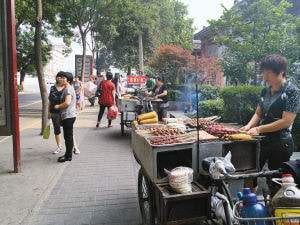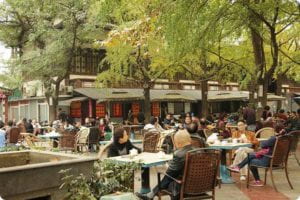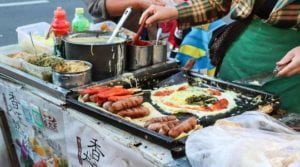In SOAS Address: Rethinking Street Vending, Krishnendu Ray comments street vending is, in fact, the issue related liveliness of global cites and livelihood of local people. Street food vendors not only need to maintain their daily life via street vending but also help cities to solve the “last mile” problem in food distribution. Such contributions to cities represent how street vending enriches the urban life. Many urban planners seek to fabricating a “world-class” city by cleaning street vending. The removal of street venders exposes crush on the checkboard layout with neat, stright and empty streets and indoor shops.
The issuse that bothers planners is that street food often relate itself with mess and dust. Street food “are all portable, visually attractive, rare foods of the poor that stand out visually. They are often crispy, crunchy, spicy, sour, sweet, and typically eaten in small bites.” (11) The strong visual appearance and taste make it more “dangerous” to clean and neat streets. However, such neat and empty streets often become a waste of public space. Jane Jacobs makes a point that it is not layout that urban planning should pay attention to, but the functions of different elements. Streets are space for pedestrians to walk by as well as space for people to communicate. Among cities in China, such as Chengdu and Beijing, citizens always gather together on the streets especially after they retire. It is because the early urbanization of China put much emphasize on efficiency where a place to rest and talk might be viewed as a waste. Under such circumstance, streets grow to be a place to communicate in his/her own community. With popularity of working couples, children would stay with retired grandparents. As a result, there are a few street vendors around squares and streets. Such natural arrangements enrich greatly the abundance in urban lives.


Another example is breakfast street vendors. Breakfast street vending is the most splendid urban view when talking about liveliness of cities. It solves well the last mile issue in food distribution when people have access to breakfast granted great mobility by street vendors. The grab-and-go breakfast makes sure urban citizens could choose among kinds of breakfast, from egg pies to noodles. As far as I am concerned, it also contains flexibility to make your own set of breakfast, which is not completely fulfilled by the food delivery system as it often requires a minimum order price. Street vending, for me, is the perfect solution to the last mile in food distribution. For instance, almost every university form naturally such a food distribution system. Students hardly order breakfast online but pick up when they walk from dormitories to classrooms.

Leave a Reply